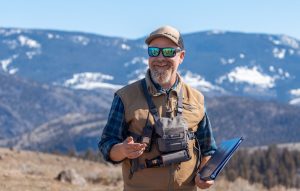“Díos mío!” A Rare Mountain Lion Sighting on Tour with Yellowstone Wild

For most of the afternoon the large, tan-colored cat was basically impossible to see, bedded down behind a boulder high on the cliff ledge. Occasionally, it rolled over or repositioned, briefly revealing its foot or head from behind the rock, and if you looked really closely you could see the black tip of the lion’s long tail twitch now and then.
Many folks came and went, hoping for a glimpse of one of Yellowstone’s most elusive and rarely seen animals. The volcanic cliffs high above the confluence of the Lamar River and Soda Butte Creek are a jumble of materials and colors perfectly suited to camouflage a lounging lion. This day, dozens, if not hundreds, of spotting scopes scoured the tawny shapes on the cliff more than a mile away, trying to distinguish what was a sleeping mountain lion from what was simply mountain.
My clients, visiting from Columbia and celebrating their 26th wedding anniversary, were determined to get a better view of the elusive cat, so we decided to wait it out. I was thrilled they had the patience, so I set us up to be comfortable waiting, potentially until dark. I repositioned our van just right to form a solid wind block, broke out the snacks, and poured lots of hot chocolate and tea. I recharged camera batteries and began to tell stories of researching mountain lions here in Yellowstone National Park in 2001 and again later in the Southwest for my graduate degree in wildlife science painting a picture of the cat’s behavior and ecology. This led to wonderful discussions as we hypothesized why we were seeing the animal where it was, what it might be doing, and how it might be interacting with its environment and the other species within the ecosystem.
The mountain lion is a master of stealth: an ambush hunter, stalking solo through the brush and rocky terrain to pounce upon its prey, which is often times larger and stronger than the lion itself. The cats strength is in its covertness, and it uses brush, rocks, and other landscape features to stay concealed from view. It moves with a slow, calculated grace so smoothly that our eyes often do not register its movement. Mountain lions have been described as haunting the forest like ghosts or moving through the trees like clouds of air, there and then gone. Most naturalists and nature adventurers in Yellowstone have never seen one, yet, if you’ve ventured into the park, the chances are that one has seen you.
Here in Yellowstone, according to researchers, a high density of the large cats (25-35 individuals) winter on the Northern Range. However, sightings are few and far between, which made my client viewing of the cat even more special.
After more than four hours of only showing glimpses of a foot or a tail, at nearly 5 p.m. the mountain lion stood up, yawned, stretched, and then walked along the base of a cliff before fully exposing itself on a snowfield. When it stretched, every muscle rippled and its long tail swung like a wisp of smoke. It walked slowly, cautiously, but with purpose pausing to look and listen completely aware of its surroundings. Given the slight build, long thin neck, and small head, I was confident this was an adult female lion. She swung her long tail as a counterbalance as she maneuvered her way up and across the soft, slick snow of the south-facing slope, which had been warmed by the late-afternoon sun. The lion then jumped onto a boulder and surveyed her surroundings before zigzagging up through rocks and trees to the top of the mountain.
By this time the other park visitors had gone in for the day, and we were alone–just my guests and me. The valley was completely quiet. Quiet, that is, except for one sound, a sound I will never forget: the Columbian-accented voice of Martha exclaiming, “Oh my God. Oh my God. Dios mio!” as the last view of the lion’s black-tipped tail disappeared over the horizon. Three sets of eyes teared up and three smiles glowed bright in the last light of day as we embraced in the success of our patience.
What a humbling treat to watch the grace of a wild mountain lion moving effortlessly among the rocky cliffs that we can only look up at from a distance and admire. A one-minute video assembled from five minutes of footage can be viewed by clicking here. Thank you, Yellowstone!
* Yellowstone’s wildlife-rich Northern Range and Lamar Valley has turned into a mecca for wildlife watchers, particularly since the restoration of wolves to the ecosystem in the mid 1990s. Every day the landscape is searched and scoured by some of the best wildlife spotters in the world, armed with incredible optics and an intimate understanding of the landscape. Some of these spotters have been doing this literally every_single_day for decades, and some of us make our living searching this landscape and showing off the park’s wildlife to visitors from around the world. Wolves, which exist at about the same density as mountain lions in this portion of the park, are seen virtually every day, and sometimes dozens of them from multiple packs. Yet, surprisingly, even with all of those trained/experienced eyes and optics searching, we are only gifted with about one sighting of the mysterious mountain lion in a year or longer, collectively-as a wildlife watching community. *

Photos, video, and text courtesy of Yellowstone Wild Owner/Operator Emil M.
To learn more about Emil and the rest of the Yellowstone Wild team visit our About Us webpage.
Stay Tuned for “Part 2” of this trip report coming soon!
